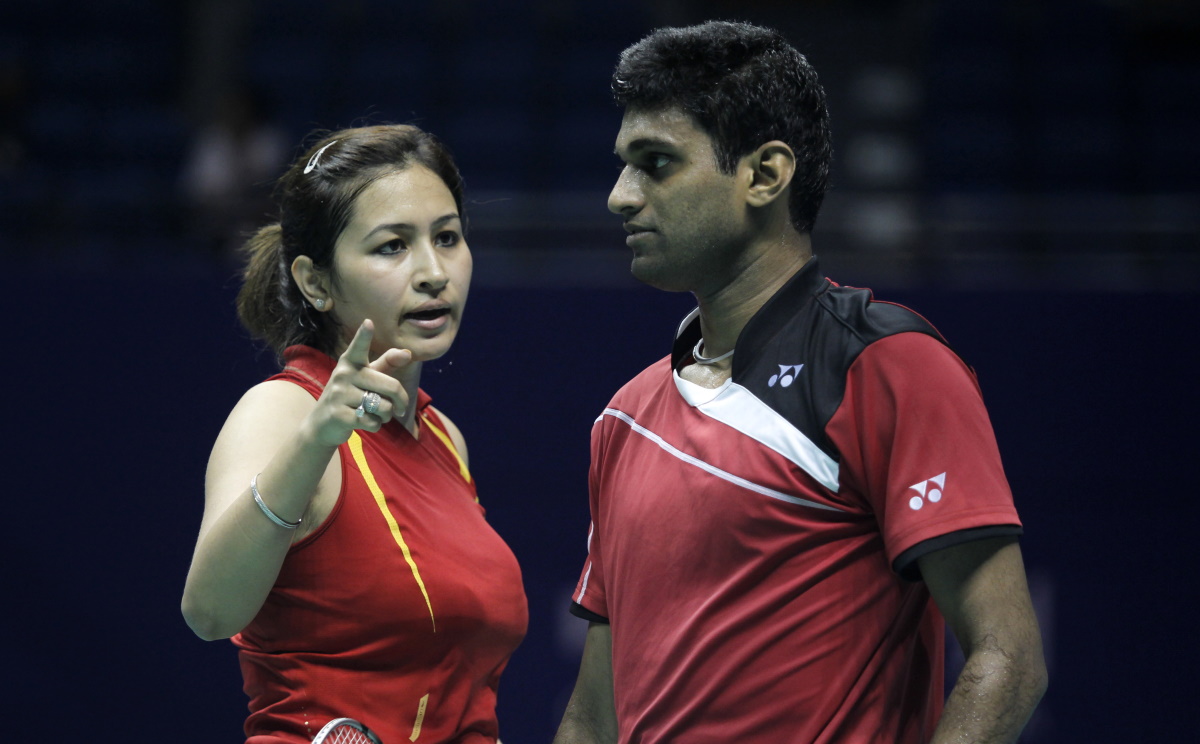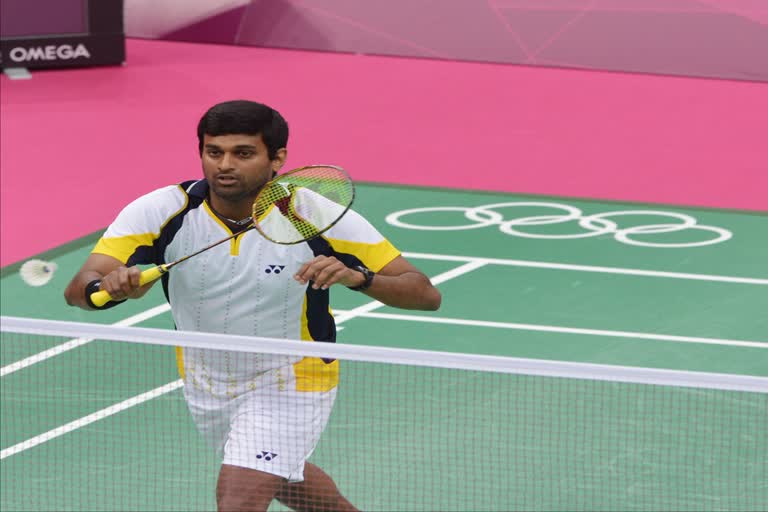Hyderabad: Post 30, most of the shuttlers take retirement from badminton and consider some other professions, but Valiyaveetil Diju, popularly known as V Diju, doesn't belong to that league. At 40, he is still going strong and making waves in the senior nationals and unsure about his retirement plan.
After teaming up with 41-year-old South Asian Games gold medallist Rupesh Kumar, Diju, the five-time national mixed doubles champion, played three senior national ranking championships and made one semifinal and two quarterfinal appearances. The duo also made it to the final of the national senior championship but lost it.
Also Read: EXCLUSIVE: 'PV Sindhu must go back to WC fitness regime to win Olympic gold'
Diju is a pioneer of a sort in the circuit of Indian mixed doubles. He represented India in the 2012 London Olympics and was the first Indian mixed doubles player to take part in the Olympics along with his long time partner Jwala Gutta.
The Diju-Jwala pairing, in fact, the first Indian mixed doubles pair to win a Grand Prix title in Bitburger Open (now SaarLorLux Open) in 2008. That year in Europe, Diju and Jwala created quite a buzz following their outstanding performance in Germany with a title in the Bulgarian Open. However, their swansong ended in the Dutch Open, where they lost the semifinal.

After they clinched the Chinese Taipei Open Grand Prix Gold tournament, the Indian pair was regarded as one of the strongest contenders for the 2009 India Open held in Hyderabad. They had put up their best performance but lost to the Indonesian pair of Flandy Limpele and Vita Marissa in the final.
2008 and 2009 arguably the best seasons for the Diju and Jwala pair as they made it to yet another final in the World Superseries Masters in Malayasia, but lost the summit clash to Denmark's Joachim Fischer Nielsen and Christinna Pedersen.
When Diju and Jwala were playing, there were hardly any other notable mixed doubles pair in India. It doesn't only mean that they lacked competition at home but it also shows India's apathy towards mixed doubles.
How did they pair up?
Though it was Diju and Jwala's own decision to pair up to play mixed doubles, advice from Edwin Iriawan, an Indonesian doubles coach who worked with the Indian team from 2010 to the start of 2014, gave a boost to their endeavour. "Initially, it was our decision to play mixed doubles. Before mixed doubles, I was playing men's doubles. But Iriawan insisted that we should pair up. After that only we started playing mixed doubles. It worked out really well," Diju told ETV Bharat in an exclusive interview from his Kochi home.
Asked how it feels like being regarded as one of the pioneers of Indian mixed doubles, Diju said, "We started our partnership in 2007-2008 and we played till 2014. I think for those six-seven years we played really well. I feel our combination worked out pretty well. For us, it was the start of a journey, we didn't think much about this back then."
However, the former World No. 6 said mixed doubles as a discipline of badminton has not progressed much in India even today. "I feel doubles and mixed doubles are in a really better condition now. 10-11 years ago, there was nothing much. Only a few players used to play doubles and mixed doubles in India. Now it is in better condition as there are many doubles players coming up and putting up good performance in international tournaments. Mixed doubles is showing promise of late, but compared to doubles, it is still a discipline represented by a small group of players. But I think two pairs from India are playing really well. I think in the next two to three years we will get to see some results."
Also Read: Badminton coach Deepthi battling the declining legacy at LB Stadium
Asked which mixed doubles pair of the country has impressed him the most in recent time, Diju said, "Satwik (Satwiksairaj Rankireddy) and Ashwini Ponappa are playing well. But Satwik is also playing men's doubles. I think playing both doubles and mixed doubles would be too difficult for him in the longer run. One more pair is Pranav Chopra and N Sikki Reddy. They are showing promise. I believe they will do well in near future."
Before the second wave of COVID-19 pandemic hit India, the 2010 Commonwealth Games mixed team silver medallist was training budding shuttlers at Badminton Gurukul in Trivandrum. Badminton Gurukul is an initiative by legendary Pullela Gopichand, who had started it in 2016 to promote sports literacy in India.
"Right now I am not a full-time coach. I am part of Badminton Gurukul. In Kerala they had started in Trivandrum and Calicut. I am part of it as a coach. I am from Kochi. So, every month I go there and train players for 10 days and come back home," said the shuttler.
However, the second wave of the pandemic forced him to stop training aspiring badminton players. "At present I am at home. Because of the stringent measures of Kerala government to curb the spread of the virus almost all stadiums are now closed here. There are no sports activities at all," said Diju, who has somehow managed to train at Regional Sports Centre, Kochi amid the pandemic.
Asked if he has any wish to become a full-time coach, the Olympian said, "Yes, of course, I want to be. But not now, I can't think about it now because of the pandemic. And I am still playing in the senior nationals. Once I stop it, I'll go for full-time coaching. At present I am playing men's doubles that is why I am not fully committed to coaching. I have not taken retirement yet."
Diju on Kerala badminton
Talking about the current health of badminton in Kerala, which produced shuttlers like HS Prannoy, Diju doesn't sound optimistic.
"Present situation of Kerala badminton is not so good. When we were playing at senior level, at least three to four players used to qualify in the national championships semifinals from various age categories. Now things have changed. Kerala is not performing really well. Only two-three singles players are there in the national tournament from Kerala. Earlier, it was not like that. In Indian team at least four to five players were from Kerala only," Diju said.
So, what caused the decline of Kerala badminton?
In response to this question, Diju blamed the lack of infrastructural development across Kerala. "In Indian badminton, academies have flourished in many cities; infrastructure has also improved a lot in other places. At every academy, players are training for almost four to five hours a day. But look at Kerala. We are lagging behind because this culture of constant training at academies is missing in our state. Ten years ago Tamil Nadu was not that good at badminton, now they are also performing well in doubles because they invested in infrastructure and promoted the sport well."
"Earlier, Kerala had a good number of badminton coaches who used to put up a lot of hard work to make players. Now in other states, especially in Hyderabad, infrastructure has improved a lot while in Kerala the infrastructure is archaic. In Hyderabad, there are many coaches and academies working constantly to produce world class shutlers. While Telangana, Andhra Pradesh, Karnataka and Tamil Nadu have emerged as major forces in Indian badminton, Kerala is falling behind because of its old system," Diju, who has recently visited Hyderabad to attend Jwala Gutta's marriage ceremony, stated.
Also Read: Badminton legend Leroy D'sa tells the untold story of Indian doubles
When badminton is moving downwards, Kerala has witnessed a surge in the popularity of track and field sports.
So, as Diju was asked whether the popularity of track and field sports affecting the prospect of badminton in the coastal state, the 2014 Arjuna awardee said, "To a certain extent it is true. Track and field and jump sports are very popular in Kerala. It is one of the biggest attractions for youths now. Youths are getting inspired by our star athletes. Therefore they are preferring athletics over badminton. In rural areas, especially, athletics is the most popular sports and badminton's presence is only limited to urban areas. Right now the situation of Kerala badminton is not really good. Some players are there, but the situation as compared to earlier is not promising."
By Sudipta Biswas



